City Palace, Udaipur
| City Palace, Udaipur | |
|---|---|
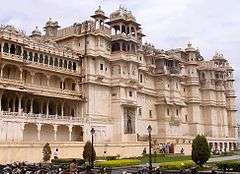 | |
 Location within Rajasthan | |
| General information | |
| Architectural style | Rajput Architecture |
| Town or city | Udaipur |
| Country | India |
| Coordinates | 24°34′34″N 73°40′59″E / 24.576°N 73.683°E |
| Construction started | 1559 |
| Completed | 16th century |
| Technical details | |
| Structural system | Marble and masonry |


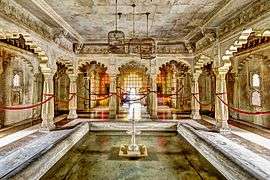
City Palace, Udaipur, is a palace complex situated in the city of Udaipur, Rajasthan. It was built over a period of nearly 400 years, with contributions from several rulers of the Mewar dynasty. Construction began in 1553, started by Maharana Udai Singh II of the Sisodia Rajput family as he shifted his capital from the erstwhile Chittor to the new found city of Udaipur.[1] The palace is located on the east bank of Lake Pichola and has several palaces built within its complex.[2][3][4][5][6]
The City Palace in Udaipur was built in a flamboyant style and is considered the largest of its type in the state of Rajasthan. It was built atop a hill, in a fusion of the Rajasthani and Mughal architectural styles, providing a panoramic view of the city and its surroundings. Overlooking Lake Pichola, several historic monuments like the Lake Palace, Jag Mandir, Jagdish Temple, Monsoon Palace, and Neemach Mata temple, are all in the vicinity of the palace complex. Nestled within the Aravali mountain range, these landmarks are associated in popular culture with the filming of the 1983 James Bond movie Octopussy.
History
The City Palace was built concurrently with the establishment of the Udaipur city by Maharana Udai Singh II and his successor Maharanas over a period of the next 400 years.The Maharanas lived and administered their kingdom from this palace, thereby making the palace complex an important historic landmark.[7][8]
The Mewar kingdom had flourished initially in Nagda (30 kilometres (19 mi) to the north of Udaipur), established in 568 AD by Guhil, the first Maharana of Mewar. In the 8th century, the capital was moved to Chittor, a hill top fort from where the Sisodias ruled for 80 years. Maharana Uday Singh II inherited the Mewar kingdom at Chittor in 1537 but by that time there were signs of losing control of the fort in wars with the Mughals. Udai Singh II, therefore, chose the site near Lake Pichola for his new kingdom as the location was well protected on all sides by forests, lakes and the Aravalli hills. He had chosen this site for his new capital, much before the sacking of Chittor by Emperor Akbar, on the advice of a hermit he had met during one of his hunting expeditions.
The earliest royal structure he built here was the Royal courtyard or 'Rai Angan',[9][10][11] which was the beginning of the building of the City Palace complex. The court was built at the location where the hermit had advised Maharana to build his new capital.[8][9][10][11][12]
After Udai Singh’s death in 1572, his son Maharana Pratap took the reins of power at Udaipur. However, he was defeated by the Mughal emperor Akbar at the Battle of Haldighati in 1576 and Udaipur fell under the Mughal rule.[13] After the death of Akbar, Mewar was given back to Maharana Pratap's son and successor Amar Singh I by Jahangir.[14][15]However, the Mughal army sent many expeditions against the Mewar empire, culminating in a peace treaty between both rulers.
But with the increasing Marathas attacks by 1761, Udaipur and the Mewar state were in dire straits and in ruins. By 1818, Maharana Bhim Singh signed a treaty with the British accepting their protection against the other empires.After the Indian independence in 1947, the Mewar Kingdom, along with other princely states of Rajasthan, merged with the democratic India, in 1949. The Mewar Kings subsequently also lost their special royal privileges and titles. The successive Maharanas, however, retained their ownership of the palaces in Udaipur and converted parts of the palace complex into heritage hotels.
Architecture
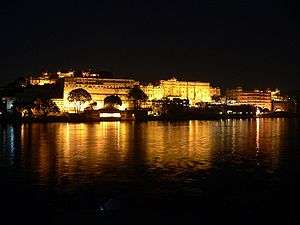
The series of palaces in the city palace complex, behind an exquisite facade of 244 metres (801 ft) length and 30.4 metres (100 ft) height, were built on a ridge on the east of lake Pichola. The complex is located in Udaipur city at 24°34′34″N 73°40′48″E / 24.576°N 73.68°E, which is set with an average elevation of 598 metres (1,962 ft).[16] They were built over a long period, from 1559 onwards, by 76 generations of Sisodia Rajputs .Several Maharanas starting with Udai Singh II, have contributed to this edifice, which comprises an agglomeration of structures, including 11 small separate palaces. The unique aspect of this conglomeration is that the architectural design is distinctly homogeneous . The palace complex has been built entirely in granite and marble. The interiors of the palace complex with its balconies, towers and cupolas exhibit delicate mirror-work, marble-work, murals, wall paintings, silver-work, inlay-work and leftover of colored glass. The complex provides a view of the lake and the Udaipur city from its upper terraces.[2][3][5][6][9][10][11][17]
The palaces within the complex are interlinked through a number of chowks or quadrangles with zigzag corridors, planned in this fashion to avoid surprise attacks by enemies. Erected in the complex, after entering through the main Tripolia (triple) gate, are the Suraj Gokhda (public address facade), the Mor-chowk (Peacock courtyard), the Dilkhush Mahal (heart’s delight), the Surya Chopar, the Sheesh Mahal (Palace of glass and mirrors), the Moti Mahal (Palace of Pearls), the Krishna Vilas (named after Lord Krishna), Shambu Niwas (royal residence now), the Bhim Vilas, the Amar Vilas (with a raised garden) that faces the Badi Mahal (the big palace), the Fateprakash Palace and the Shiv Niwas Palace; the last two have been converted into heritage hotels. The complex is set with facilities of a post office, bank, travel agency, numerous craft shops and also an Indian boutique belonging to the World Wildlife Fund (WWF) . The entire complex is the property of the Mewar royal family with various trusts maintaining the structures.
Structures within the complex
- Gateways



Gateways, colloquially called Pols, are set to the east of Udaipur city .A number of such gateways provide access to the palace complex.
The main entry from the city is through the 'Bara Pol' (Great Gate), which leads to the first courtyard. Bara Pol (built in 1600) leads to the ‘Tripolia Pol', a triple arched gate built in 1725, which provides the northern entry. The road between this gate and the palace is lined with shops and kiosks owned by craftsmen, book-binders, miniature painters and textile dealers. Between these two gates, eight marble arches or Toranas are erected. It is said that the Maharanas used to be weighed here with gold and silver, which was then distributed among the local people. Following the Tripolia gate is an arena in front of the Toran Pol and the facade palace, the Manak Chowk, where elephant fights were staged in the past to test their prowess before starting on war campaigns.[6][7][10][18]
The main block of the city palace is approached through a modest door from the Ganesha Deodhi terrace. The door is flanked by whitewashed walls vibrantly painted with martial animals in the traditional Rajput style.[3]
- Amar Vilas
Amar Vilas is the uppermost court inside the complex, which is an elevated garden. It provides entry to the Badi Mahal. It was built in Mughal style as a pleasure pavilion . It has cussed arcades enclosing a square marble tub.[3]'Amar Vilas' is the highest point of the City palace and has wonderful hanging gardens with fountains, towers and terraces.[6]
- Badi Mahal
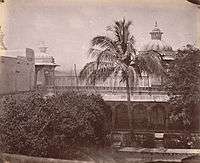
Badi Mahal (Great Palace) also known as Garden Palace is the central palace situated on a 27 metres (89 ft) high natural rock formation bis-a-bis the rest of the palace. The rooms on the ground floor appear to be at the level of the fourth floor in view of the height difference to its surrounding buildings. There is a swimming pool here, which was then used for Holi festival (festival of colors) celebration. In an adjoining hall, miniature paintings of 18th and 19th centuries are displayed. In addition, wall paintings of Jag Mandir (as it appeared in the 18th century), Vishnu of Jagdish temple, the very courtyard and an elephant fight scene are depicted.[6][19]

- Bhim Vilas
Bhim Vilas has a gallery of a collection of miniature paintings that depict the real-life stories of Radha-Krishna.[6]
- Chini Chitrashala
Chini Chitrashala (Chinese art place) depicts Chinese and Dutch ornamental tiles.[6]
- Choti Chitrashali
Choti Chitrashali or 'Residence of Little Pictures', built in early 19th century, has pictures of peacocks.[9]
- Dilkhusha Mahal
Dilkhusha Mahal or ‘Palace of Joy’ was built in 1620.[9]
- Durbar hall
Durbar Hall was built in 1909 within the Fatehpraksh Palace as a venue for official functions such as State banquets and meetings .The gallery of the hall was used by the Royal ladies to observe the Durbar proceedings. This hall has a luxuriant interior with large chandeliers. Weapons of the maharanas and some of their portraits are depicted here. The foundation stone for this hall was laid by Lord Minto, the Viceroy of India, in 1909, during the rule of Maharana Fateh Singh and was then called Minto Hall.[10]
- Fateprakash Palace
Fateprakash Palace, which is now a luxury hotel, has a crystal gallery that consists of crystal chairs, dressing tables, sofas, tables, chairs and beds, crockery, table fountains which were never used. There is also a jewel studded carpet here. Maharana Sajjan Singh had ordered these rare items in 1877 from F& C Osler & Co of London but he died before they arrived here. It is said that the packages containing these crystals remained unopened for 110 years.[10]

- Krishna Vilas
Krishna Vilas is another chamber, which has a rich collection of miniature paintings that portray royal processions, festivals and games of the Maharanas.[6]
- Laxmi Vilas chowk
Laxmi Vilas Chowk is an art gallery with a distinctive collection of Mewar paintings.[6]
- Manak Mahal
The Manak Mahal approached from the Manak Chowk is an enclosure for formal audience for the Mewar rulers. It has a raised alcove inlaid completely in mirror glass. Sun-face emblems, in gleaming brass, religious insignia of the Sisodia dynasty are a recurring display at several locations in the City Palace with one being depicted on the façade of the Manak Chowk. The largest of such an emblem is also seen on the wall of the Surya Chopar, a reception centre at the lower level. Surya or Sun emblem of the Mewar dynasty depicts a Bhil, the Sun, Chittor Fort and a Rajput with an inscription in Sanskrit of a quotation from the Bhagavad Gita (Hindu holy scripture), which means “God Helps those who do their duty". It was customary for the Maharanas to offer obeisance to the Sun facing east, every morning before taking breakfast.[3][6][11]
- Mor Chowk


Mor Chowk or Peacock square is integral to the inner courts of the palace. The elaborate design of this chamber consists of three peacocks (representing the three seasons of summer, winter and monsoon) modeled in high relief and faced with coloured glass mosaic, built into successive niches in the wall area or jharoka, These were built during Maharana Sajjan Singh’s reign, 200 years after the palace was established. The peacocks have been crafted with 5000 pieces of glass, which shine in green, gold and blue colours. The apartments in front of the Chowk are depicted with scenes of Hindu god Lord Krishna’s legends. At the upper level, there is a projecting balcony, which is flanked by inserts of coloured glass. In an adjoining chamber, called the Kanch-ki-Burj, mosaics of mirrors adorn the walls. The Badi Charur Chowk within this chowk is a smaller court for private use. Its screen wall has painted and inlaid compositions depicting European men and Indian women. Proceeding further from the Mor-Chowk, in the Zenana Mahal or women’s quarters exquisitely designed alcoves, balconies, colored windows, tiled walls and floors are seen.[3][6]
- Rang Bhawan
Rang Bhawan is the palace that used to hold the royal treasure. There are temples of Lord Krishna, Meera Bai and Shiva located here.[6]
- Sheesh Mahal
Sheess Mahal or Palace of Mirrors and glasses was built in 1716[9] by Maharana Pratap for his wife Maharani Ajabde.
- Museum
In 1974, a part of the city palace and the 'Zenana Mahal' (Ladies Chamber) were converted into a museum. The museum is open for public.
Visitor information

The city palace is accessible from Udaipur city, which is well connected by road, rail and air links with the rest of the country.
The city lies on the Golden Quadrilateral, midway between Delhi and Mumbai National Highway (NH) 8; it is about700 kilometres (430 mi), from either metro. The East West Corridor, which starts from Porbandar and ends at Silchar, passes and intersects the Golden Quadrilateral and shares the common space from Udaipur to Chittor.
Train connectivity is established between Delhi, Jaipur and Ahmedabad through trains run by Indian Railway. Udaipur is connected with Delhi, Kota and Mathura with the "Mewar Express" on broad gauge tracks. Udaipur is connected with Kolkatta, by the "Ananya Express". A train has also been introduced between Mumbai and Udaipur via Vadodara, Ratlam and Chittorgarh.
Dabok airport, also known as Maharana Pratap Airport, is 24 kilometres (15 mi) from the city centre. Daily flights connect Udaipur with Jaipur, Mumbai and Delhi.
The city palace can be reached from the city by unmetered taxis, auto rickshaws, tongas and city bus service.[20]
In popular culture
The palace was picturised as a hotel in the 1985 James Bond film Octopussy, where Bond (played by Roger Moore) stayed as he began his quest to apprehend the antagonist Kamal Khan (Louis Jordan).
A 1991 documentary film directed for television by Werner Herzog called Jag Mandir consists of footage of an elaborate theatrical performance for the Maharana Arvind Singh Mewar at the City Palace staged by André Heller.
The palace was used for filming part of Goliyon Ki Raasleela Ram-Leela (English: A Play of Bullets: Ram-Leela) 2013 directed by Sanjay Leela Bhansali.
The palace area of Manak Chowk serves as the venue of the annual Maharana Mewar Foundation Awards, honouring students, national and international personalities.[21]
Gallery
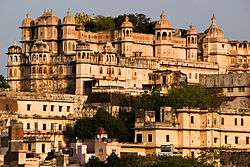 City Palace
City Palace_in_the_foreground%2C_Udaipur.jpg) Palace View of courtyards towards Lake Pichola
Palace View of courtyards towards Lake Pichola Exterior view of corner of the palace
Exterior view of corner of the palace%2C_-Udaipur-.jpg) Rear View of the Palace
Rear View of the Palace Elephant carvings on Jagdish Mandir
Elephant carvings on Jagdish Mandir Inside view of City Palace, Udaipur.
Inside view of City Palace, Udaipur. Rajasthani painting of Lord Ganesha, City Palace.
Rajasthani painting of Lord Ganesha, City Palace. Royal Swing inside the Palace
Royal Swing inside the Palace King's Lavatory
King's Lavatory Aerial Photography in India
Aerial Photography in India
Notes
- ↑ UDAIPUR: Since 1553 CE!-Its Founding & a Concise Photo Fact-File. Ranawat, P. S., 2014. ISBN 978-81-929881-0-8. Kumbha Exclusives, India.
- 1 2 Brown, Lindsay; Amelia Thomas (2008). Rajasthan, Delhi and Agra. City Palace and Museums. Lonely Planet. p. 244. ISBN 1-74104-690-4. Retrieved 2009-12-13.
- 1 2 3 4 5 6 George, Michell; Antoni Martinelli (1994). The Royal Palaces of India. City Palace Udaipur. London: Thames and Hudson Ltd. pp. 130–135. ISBN 0-500-34127-3.
- ↑ Henderson, Carol E; Maxine K. Weisgrau (2007). Raj rhapsodies: tourism, heritage and the seduction of history. The City palace. Ashgate Publishing, Ltd. pp. 93, 95–96. ISBN 0-7546-7067-8. Retrieved 2009-12-13.
- 1 2 "History of Udaipur". Retrieved 2009-12-10.
- 1 2 3 4 5 6 7 8 9 10 11 12 "City Palace, Udaipur". Retrieved 2009-12-10.
- 1 2 Abram, David (2003). Rough guide to India. Udaipur, History, City Palace. Rough Guides. pp. 226–228, 233. ISBN 1-84353-089-9. Retrieved 2009-12-13.
- 1 2 Choy, Monique; Sarina Singh (2002). Rajasthan. Udaipur. Lonely Planet. p. 235. ISBN 1-74059-363-4. Retrieved 2009-12-15.
- 1 2 3 4 5 6 Henderson p. 95
- 1 2 3 4 5 6 Singh, Sarina (2005). India. City Palace and Museum. Lonely Planet. pp. 191–192. ISBN 1-74059-694-3. Retrieved 2009-12-13.
- 1 2 3 4 Ward p.195
- ↑ Choy p.241
- ↑ Abram p.228
- ↑ A military history of medieval India, 2003, p. 530,
Prince Pravez and Asaf Khan led an army of 20,000 horse which fought a battle against Rana Amar Singh at Dewar
- ↑ Srivastava 1969, p. 269.
- ↑ "Udaipur Weather". Retrieved 2009-12-15.
- ↑ "City Palace, Udaipur". Retrieved 2009-12-14.
- ↑ Henderson p. 95-96
- ↑ Ward, Philip (1989). Northern India, Rajasthan, Agra, Delhi: a travel guidework= City Palace, Udaipur. Pelican Publishing Company. pp. 193–195, 197–198. ISBN 0-88289-753-5. Retrieved 2009-12-13.
- ↑ "Udaipur City Bus/City Bus View". National Informatics Centre. Retrieved 2009-12-14.
- ↑ "Maharana Mewar Foundation Awards". Retrieved 2016-09-05.
Further reading
- The City Palace Museum, Udaipur: paintings of Mewar court life, by Andrew Topsfield, Pankaj Shah, Government Museum, Udaipur. Mapin, 1990. ISBN
094414229X.
References
| Wikimedia Commons has media related to City Palace (Udaipur). |
- Abram, David (2003). Rough guide to India. Rough Guides. p. 1404. ISBN 1-84353-089-9.
- Arnett, Robert (2006). India Unveiled. Atman Press. pp. 216Z. ISBN 0-9652900-4-2.
- Brown, Lindsay; Amelia Thomas (2008). Rajasthan, Delhi and Agra. Lonely Planet. p. 420. ISBN 1-74104-690-4.
- Choy, Monique; Sarina Singh (2002). Rajasthan. Lonely Planet. p. 400. ISBN 1-74059-363-4.
- Henderson, Carol E; Maxine K. Weisgrau (2007). Raj rhapsodies: tourism, heritage and the seduction of history. Ashgate Publishing, Ltd. p. 236. ISBN 0-7546-7067-8.
- Singh, Sarina (2005). India. Lonely Planet. p. 1140. ISBN 1-74059-694-3.
- Ward, Philip (1989). Northern India, Rajasthan, Agra, Delhi: a travel guide. Pelican Publishing Company. p. 240. ISBN 0-88289-753-5.